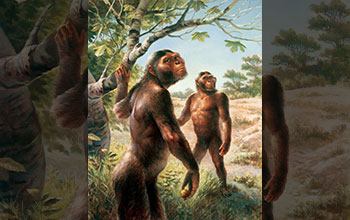Multimedia Gallery
Illustration showing a pair of foraging Australopithecus afarensis
This illustration interprets a pair of foraging Australopithecus afarensis, known most famously from the fossil of "Lucy," unearthed by Donald C. Johanson in 1974 in Hader, Ethiopia.
What did early human ancestors look like? Fossil evidence reveals much, but proposed answers to this question must incorporate conjecture. For example, patterns of hair growth and coloration may remain forever unknown, although modern apes present reasonable analogies. Males (seen in the background here) were typically much larger and heavier than females. Afarensis was certainly adapted to upright walking, but still retained powerful arms for tree climbing. (Date of Image: 1999)
Credit: Michael Hagelberg/Arizona State University Research Magazine
Special Restrictions: Important: The owner has restricted the use of this image. Permission is granted to use the image for personal, educational and nonprofit/non-commercial purposes only. Permission to use the image in any other manner is prohibited without prior permission from the owner. Contact Michael Hagelberg by e-mail, hberg@asu.edu; or by telephone, (480) 965-1266.
Images and other media in the National Science Foundation Multimedia Gallery are available for use in print and electronic material by NSF employees, members of the media, university staff, teachers and the general public. All media in the gallery are intended for personal, educational and nonprofit/non-commercial use only.
Images credited to the National Science Foundation, a federal agency, are in the public domain. The images were created by employees of the United States Government as part of their official duties or prepared by contractors as "works for hire" for NSF. You may freely use NSF-credited images and, at your discretion, credit NSF with a "Courtesy: National Science Foundation" notation.
Additional information about general usage can be found in Conditions.
Also Available:
Download the high-resolution JPG version of the image. (21.4 MB)
Use your mouse to right-click (Mac users may need to Ctrl-click) the link above and choose the option that will save the file or target to your computer.



